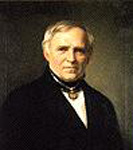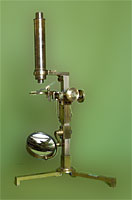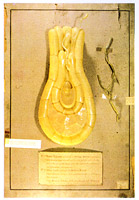A biography of Giovanni Battista Amici
1844-1846 - Second trip to Paris and London. Berlin. On the fertilization of Orchids -  return to index
return to index
1844 is the year of Amici’s second major trip to Paris and London. There is no diary of this trip, but information about it can be gleaned from correspondence, newspapers of the period, passports and hotel receipts. We know that in Paris he saw Biot and Guinand in May, and Lerebours and Fizeau in June; he showed them his new microscope and discussed daguerreotyping with them.
Vicenzo Amici accompanied his father on this trip as well, and on 21 June he wrote a letter from Paris to Giovanni Battista Lenna, head of the workshop in Florence. In it he wrote: “Here the instruments of Papa have been a huge success because they are superior in quality to the ones produced in Paris. All of the opticians want to copy them, and we have the house full of designers sketching them. We are leaving this week for London, where we’ll remain about ten days [...]. Find a copy of the 20 June edition of the Debats (French newspaper) and you’ll see what a wonderful article there is in it about Papa’s work”.
The article in the Journal des Débats, written by the medical doctor Alphonse Donnè, read in part:
le voyage actuel de M. Amici a une importance particulière; nous ne craignons pas de dire que son séjour à Paris fera époque dans l'histoire des microscopes, par les admirables perfectionnemens qu'il est venu nous faire connaître, par l'infatigable complaisance et la libéralité avec lesquelles il cherche à les propager, mettant autant de zèle et de soin à initier les opticiens à ses secrets, à les encourager, à les pousser dans la bonne voie, en leur livrant les résultats de ses longues et laborieuses investigations, que d'autres pourraient en mettre à profiter seuls de leurs découvertes.
Tout le monde est d'accord pour reconnaître la supériorité des microscopes de M. Amici; personne ne peut leur contester une puissance, une précision que nous n'avons pas atteinte. Non, certes, que nous prétendions rabaisser le mérite des habiles artistes que nous possédons, que par une ridicule exagération nous cessions d'estimer les microscopes sortis des mains de Trécourt et d'Oberhauser, ou de Charles Chevalier: M. Amici lui-même est le premier à rendre justice à ces excellens instrumens, si justement appréciés des savans les plus distingués de l'Europe; mais néanmoins nous devons dire que M.Amici est en avant, qu'il a fait un pas remarquable dans un point où il semblait si difficile de franchir la limite où s'arrêtaient nos moyens de scruter les infiniment petits et de pénétrer les secrets de la nature. Pour donner une idée de ce progrès, sans entrer dans des détails optiques qui seraient déplacés ici, il suffira de dire que M. Amici possède des pouvoirs amplifians de douze cents fois, avec une netteté et une lumière qui nous abandonnent dans nos meilleurs instrumens au-delà de six cents.
Mais aussi, qui était mieux placé que M. Amici pour obtenir de pareils résultats? Savant profond en même temps qu'opticien habile, possédant à la fois la théorie et la pratique, partant de l'une pour arriver à l'autre, calculant aussi bien les courbes de ses lentilles qu'il connaît les procédés et jusqu'aux tours de main de l'art, M. Amici réunit, comme Savart, comme Fraunhofer, comme quelques autres savans bien rares, les notions et les qualités que se partagent ordinairement le savant et l'artiste.
 On 28 June Amici received a note from Nachet at the Hotel de Lion: “Avant votre départ permettez à un simple ouvrier de vous féliciter, en vous rendant l’hommage que vous meritez à juste titre, pour vos combinaisons de jeux de lentilles achromatiques, et par conséquent pour vos beaux effets microscopiques; qui ne se sont pas vus jusqu’à présent. Nachet Opticien Quai aux Fleurs 17”.
On 28 June Amici received a note from Nachet at the Hotel de Lion: “Avant votre départ permettez à un simple ouvrier de vous féliciter, en vous rendant l’hommage que vous meritez à juste titre, pour vos combinaisons de jeux de lentilles achromatiques, et par conséquent pour vos beaux effets microscopiques; qui ne se sont pas vus jusqu’à présent. Nachet Opticien Quai aux Fleurs 17”.
John Quekett wrote in his Practical treatise on the use of the microscope:
In the year 1844 Professor Amici visited this country, and brought with him an object-glass of one-seventh of an inch focal length, with an aperture of 112°; this combination was in part composed of Dr. Faraday's dense glass. Mr. Ross copied Amici's construction; but found the dense glass so exceedingly soft and fragile, as to render it unfit to receive the high polish essential to the correct performance of any object-glass: he also noticed that Amici's glasses were much tarnished; he then devised a new construction, whereby, with the ordinary dense glass, he obtained an aperture in the one-eight of 85°, and in the one-twelfth as high as 135°.
 On the way from London to Italy, Amici went through Berlin. The Berlin mathematician Carl Wilhelm Borchardt (1817-1880), a friend of Bessel, wrote Amici in his hotel on 12 August about a trip they were to take to Potsdam the next day. A note written the same day to Amici from Christian Gottfried Ehrenberg seems to indicate that he and Amici visited Friedrich Wilhelm Schiek, the most important microscope maker in the Prussian capital at that time, and that they were accompanied by Alexander von Humboldt, who was curious to see the Florentine microscope.
On the way from London to Italy, Amici went through Berlin. The Berlin mathematician Carl Wilhelm Borchardt (1817-1880), a friend of Bessel, wrote Amici in his hotel on 12 August about a trip they were to take to Potsdam the next day. A note written the same day to Amici from Christian Gottfried Ehrenberg seems to indicate that he and Amici visited Friedrich Wilhelm Schiek, the most important microscope maker in the Prussian capital at that time, and that they were accompanied by Alexander von Humboldt, who was curious to see the Florentine microscope.
The last bit of information we have about this trip is to be found in the note on the Meridiana iconantidiptica (Iconantidiptic Meridian) written in 1855, where Amici mentions that the idea for this instrument came to him after seeing Dent’s Dipleidoscope for the first time when he visited Enke in Berlin in August 1844.
Meanwhile, Jean Baptiste François Soleil (1798-1878) built a polarizing microscope based on drawings and under the direction of Amici, while the “Annales de Chimie et de Physique” published Note sur un appareil de polarisation and Description du petit microscope achromatique de M. Amici. Amici presented Sulla struttura degli stomi (On the structure of stomas) and Descrizione di una meridiana di sua invenzione (Description of a meridian of his invention) at the Sixth Meeting in Milan on his way back to Florence.
 At the Botanical Section of the Eighth Italian Scientific Meeting on 16 September, 1846, Amici read his historically important paper Sulla fecondazione delle Orchidee (On the fertilization of Orchids) where he discussed the issue of whether fertilization in the phanerogamous plants was as described by Schleiden. This latter maintained that the tip of the pollen tube of these plants penetrated into the integuments of the ovule, pushed back the membrane of the embryonic sac, formed a hollow space for itself there and then converted into an embryo. After having recalled his work on the fertilization of the pumpkin, where he had considered Schleiden’s opinion as inadmissible, and after presenting the observations of Adolf Brongniart and of Robert Brown about the fertilization of Orchids, Amici presented his own observations carried out on various species of the Orchid family.
At the Botanical Section of the Eighth Italian Scientific Meeting on 16 September, 1846, Amici read his historically important paper Sulla fecondazione delle Orchidee (On the fertilization of Orchids) where he discussed the issue of whether fertilization in the phanerogamous plants was as described by Schleiden. This latter maintained that the tip of the pollen tube of these plants penetrated into the integuments of the ovule, pushed back the membrane of the embryonic sac, formed a hollow space for itself there and then converted into an embryo. After having recalled his work on the fertilization of the pumpkin, where he had considered Schleiden’s opinion as inadmissible, and after presenting the observations of Adolf Brongniart and of Robert Brown about the fertilization of Orchids, Amici presented his own observations carried out on various species of the Orchid family.
Mohl commented in 1863 that Schleiden’s reply to Amici’s observations on the fertilization of the Cucurbita Pepo had left this latter “perfectly calm; he wrote me that he knew he had seen correctly, that surely sooner or later someone would have confirmed his observations, that he was a peaceful person and so he would not respond to Schleiden. In recompense, he received a splendid satisfaction. A few months later he produced a microscope for Schleiden which would have made this  latter able to observe better, and Amici demonstrated the correctness of his own theories on the fertilization through new research made on Orchids, which he presented to the Congress of Scientists in Genoa in September 1846. [...] In this work Amici gave the first-ever correct and coherent exposition of the overall process of the fertilization of a plant in all its stages, from the pollination of the stigma through to the full development of the embryo. This was the model for all subsequent research and at the same time the final blow to the mistaken theory of Schleiden. At this point Amici could calmly put the subject aside and leave further research on the matter to others; within a few years the victory of his theory was a universally recognized fact.
latter able to observe better, and Amici demonstrated the correctness of his own theories on the fertilization through new research made on Orchids, which he presented to the Congress of Scientists in Genoa in September 1846. [...] In this work Amici gave the first-ever correct and coherent exposition of the overall process of the fertilization of a plant in all its stages, from the pollination of the stigma through to the full development of the embryo. This was the model for all subsequent research and at the same time the final blow to the mistaken theory of Schleiden. At this point Amici could calmly put the subject aside and leave further research on the matter to others; within a few years the victory of his theory was a universally recognized fact.
Bibliography
H. von Mohl, Giambattista Amici, “Botanische Zeitung”, N. 51, 18. December 1863 (Italian translation by A. Meschiari, “Atti della Fondazione Giorgio Ronchi”, 2-1999); Roberto Savelli, Giovan Battista Amici, botanist, “Physis”, 1-1965; A. Meschiari, Corrispondenza di G. B. Amici con A. von Humboldt, L. Oken, M. Faraday, E. du Bois-Reymond, “Atti della Fondazione Giorgio Ronchi”, 4-1997; Id., Corrispondenza di G. B. Amici con ottici e meccanici (Buron, Chevalier, Duboscq, Ertel, Fraunhofer, Guinand e Feil, Hartnack, Lerebours, Merz, Nachet, Oberhaeuser), “Atti della Fondazione Giorgio Ronchi”, 4/5-2000; Id ., The microscopes of Giovanni Battista Amici, Tassinari, Firenze 2003; Id., Il Libro de’ conti del laboratorio di Giovanni Battista Amici e altri documenti inediti, Tassinari, Firenze 2003.
